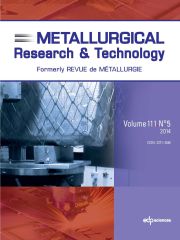Article contents
Electrowinning of Iron in Aqueous Alkaline SolutionUsing Rotating Disk Electrode
Published online by Cambridge University Press: 09 October 2009
Abstract
In order to develop a new, efficient industrial process forproducing high quality iron and steel with significantly reducedcarbon dioxide emissions, we investigated the electrowinningof iron from an iron oxide ore in aqueous alkaline solutions.Hematite (Fe2O3) solid particles suspended in the concentratedaqueous sodium hydroxide (NaOH) solutions were transferredto the cathode (e.g., a rotating disk graphite electrode) andreduced to iron metal by applying a constant current; oxygenwas evolved on the anode (e.g., a nickel screen mesh). Currentefficiencies of above 90% with respect to iron depositionwere consistently obtained under the specific conditions in alaboratory cell, and the corresponding energy consumptionswere calculated to be around 3 kWh·kg-1 iron. The depositediron crystals were the oriented clusters of stacked six-fold twins ina tetrahedron-shape grew growing in a direction perpendicularto the cathode surface. Influences of rotation rates of the cathode,cathodic current densities, contents of the Fe2O3 particlesin electrolytes, and concentrations of NaOH solutions oncurrent efficiency and morphology of deposits were studied.
Information
- Type
- Research Article
- Information
- Metallurgical Research & Technology , Volume 106 , Issue 10: Selected papers from 4th ULCOS SEMINAR (Part 2) , October 2009 , pp. 455 - 459
- Copyright
- © La Revue de Métallurgie, 2009
- 5
- Cited by

